Psionics : Practical Application of Psychic Awareness
by Michael Murphy, bibliotecapleyades.netby Jeffrey Mishlove, PhD
The Roots of Consciousness
from WilliamJames Website
Can psychic powers be used for detrimental purposes? What are the limits of psychic ability? Certainly some inferences can be obtained by drawing upon the history, the literature, and the folk-wisdom of psi. I sometimes use the term "psionics," taken from the science fiction literature, to describe the applied branch of psi exploration.
Psionics is not particularly concerned with the truth value of scientific, pseudoscientific or religious theories about the nature of psychic functioning. It is concerned with the practical utility of such theories for individual practitioners. It is concerned with reliability, consistency and magnitude of psi effects, not in the laboratory, but in the world of business and professional affairs.
Harmful Purposes
Many traditions teach that psychic abilities can only be used for good purposes, for instance healing. Other harmful applications are said either not to work or to rebound back upon the evil-wisher. Dr. Louisa E. Rhine, who had made a lifelong study of spontaneous psychic experiences, took such a stance in responding to the question of a seventh-grade inquirer:
No Nancy, ESP could not possibly be used to hurt anyone physically or mentally. It is true that sometimes people get the false idea that someone is influencing them by ESP. They think it is by telepathy, but this is very unlikely. Telepathy seldom, if ever, works that way, for no one can send his thought to another and make him take it...
The only way a person could be hurt would be by his belief that he could be so affected. It is possible sometimes for a person to "think himself sick" for other reasons and in the same way he could think himself sick by believing that someone was affecting him by telepathy. But, if so, his sickness would be caused by mistaken suggestion, not by telepathy.
Mrs. Rhine’s answer is reassuring and also reflects an understanding of the psychological mechanisms involved in mediating psi. It seems quite reasonable to think individuals can reject telepathic suggestions as easily as you, the reader, might reject any statement you read in this book. For an aware and enlightened individual this would certainly be the case. It is also the case that much of what we think of as psychic phenomena is merely due to suggestion.
The anthropological literature regarding tribal cultures indicates that the violation of a taboo and the placement of a hex can result in death within a few days. This has be attributed to an extreme operation of the stress-response syndrome by modern researchers. We might consider the reported instances of deaths, illness, and accidents from hexes, voodoo, spells, and curses to be the result of suggestion.
Although, we might just as easily ask ourselves whether, if psi could heal people independently of suggestion, it could not also be used to harm them. Perhaps psi -- like electricity -- is a neutral force from a moral perspective? A number of apparent hexes seem to have occurred without even the knowledge of the victim.
The research of the Soviet physiologist Leonid Vasiliev suggests that telepathic hypnotic induction may be occasionally instrumental in effective behavior manipulation over distances. Similar telepathic experiments have been used to awaken sleeping subjects, with slightly less success. However, few subjects are so susceptible and we have yet to understand the mechanisms that differentiate good and poor subjects.
National Security Applications
Ancient History and Folklore
The BibleIn the Bible as related in Kings II, vi, the prophet Elisha used clairvoyant abilities to inform the King of Israel about the battle plans which the king of Syria had formed against him. Informed of Elisha’s abilities, the Syrian king sent a host of chariots and horsemen to capture the prophet. However, according to the biblical account, Elisha used his abilities to blind and confuse the Syrians so that they would be captured by the Israelites.
Similar and even more dramatic tales are told of the exodus of the Jewish nation from Egypt; of the original Hebrew conquest of Canaan; and of the subsequent military conquests of Saul, David and Solomon.
Asian Martial Arts
The earliest treatise on warfare, The Art of War, written in 500 B.C. by the Chinese general Sun Tzu, details the intimate link between success in battle and the skilled management of a "force" which was called ch’i. The basic principles are elucidated in this amazing document.
Sun Tzu argues that wars are won through a combination of conventional military tactics and a variety of extraordinary methods which involve the knowledge and control of ch’i, which flows through the body of the warrior and can be used to influence the mind of the enemy to produce illusions, deception and weakness.
The warrior cultivated ch’i through self-knowledge gained by following the mystical Taoist traditions. Mental stillness and other psi-conducive stated enabled the warrior to obtain a poise and concentration so intense that it was effortless in its deadly spontaneity. Such training emphasized the ability to maintain the meditative state in the midst of intense physical activity. The martial arts trained the warrior to take advantage of the slightest break in the enemy’s concentration.
Joan of Arc.
A peasant girl with no military training, followed her visions and voices to lead the bedraggled armies of France to victory against the English. Many ostensibly miraculous events -- the subject of continuing historical debate -- led to the French Dauphin’s appointment of Joan as the titular head of his army. Joan was burned at the stake in 1431 as a witch. In 1456, an ecclesiastical court proclaimed the iniquity of her first trial and annulled its judgment. In 1920, she was canonized as a saint by the Roman Catholic Church.
The World Wars
In June 1919, in an action against the Hungarian Republic, Czech soldiers were put into a hypnotic state and asked to clairvoyantly scan the landscape to determine the enemy’s strength and position. A pamphlet titled Clairvoyance, Hypnosis and Magnetic Healing at the Service of the Military, written in 1925 by karl Hejbalik, reports that the information obtained through these non-normal means always proved correct when later checked through normal means.The contemporary Czech psychotronic researcher Zdenek Rejdak interviewed the individuals involved in the Czech psi maneuvers. According to Rejdak, they confirmed Hejbalik’s account "in all details."
The Nazis are said to have assembled many powerful occult adepts from Tibet and Japan to train and advise them. One of the most important and powerful groups in Germany was the Nazi Occult Bureau, which attempted to use occult forces for espionage and the magical control of events including a conscious, pseudo-Nietzschean attempt to replace Christianity with the ancient Teutonic myth of the war god, Wotan. Coincidentally, in the early 1930s, the great Swiss psychiatrist Carl Jung noticed a marked pattern of imagery of the war god Wotan in the dreams of his German patients. The situation was so dramatic that it prompted him to write, in an essay in 1933, that the German people were subconsciously preparing themselves for war.
Hitler obtained extensive occult training from the German nationalistic Vril Society and the adept circle known as the Thule Group. Teachings of these groups account for many aspects of Nazi culture which are inexplicable in terms of ordinary historical scholarship.
Hitler’s personal psychic abilities, especially clairvoyant and precognitive visions, were by some accounts instrumental in many of the dramatic tactical victories during the early period of the war. Eventually, his intoxication with power and the use of drugs so poisoned his mind that he compulsively followed instructions received through visions, and these led to disastrous strategic errors.
British and American intelligence employed astrologers and clairvoyants to anticipate the occult advice being given to Hitler and his forces. According to The Psychic Spy by Linedecker, the Allies resorted to using a group of out-of-body practitioners to scout key locations inside enemy territory from an island in the Atlantic.
Lord Hugh Dowding, head of the Royal Air Force during World War II, and often called "the man who won the Battle of Britain," had experiences during the war which led him later to become a major figure in the spiritualist movement. Released secret documents of the British Army reveal that Dowding’s wife was a sensitive.
Using methods now known among psi researchers as "remote viewing," she was able to detect enemy air bases that the army had not discovered through conventional surveillance. These abilities were coupled with a spiritualistic belief which so impressed Lord Dowding that he believed himself to be in contact with spirits of the British airmen who had been downed in battle.
Another of the great Allied commanders during World War II, U.S. Army General George S. Patton, reputedly possessed rare psi abilities. Patton believed himself to be the reincarnation of an ancient Roman general. General Omar N. Bradley, Patton’s commanding officer during the war, has confirmed Patton’s clairvoyant and precognitive abilities, referring to them as his "sixth sense." Bradley details a wartime example: after crossing the Moselle River near Coblenz with some three divisions moving south, Patton suddenly stopped his advance and collected his forces for no known reason.
Questioned by subordinates about this strange behavior, Bradley expressed confidence that Patton had "felt" something that "was not apparent from the information we had at the time," which justified his action. The following day, Patton’s forces were hit by a strong and otherwise unexpected counterattack which the general was able to repel only because he had earlier stopped to regroup.
Soviet interest in psi was kindled during World War II by a series of unusual events which transpired between Joseph Stalin and the well-known Polish psychic, Wolf Messing. By using telepathic hypnosis to suggest to Stalin’s guards and servants that he was Lavantri Beria, the head of Soviet secret police, Messing was reputedly able to walk past them unchecked into Stalin’s personal dacha and into the very room where Stalin was working. Stalin’s subsequent tests of Messing’s abilities were published in the Soviet Journal, Science and Religion.
Eastern Europe
In the 1920s, Professor Lionid Vasiliev, Director of Leningrad University’s Department of Physiology, initiated a series of experiments into the effects of mental suggestion at a distance. Vasiliev was motivated in part by reports of the French physiologist Pierre Janet, and perhaps also by the extraordinary power which the monk Rasputin once held over the entire Russian ruling family.Vasiliev began by attempting to influence a hypnotized subject to move his arm, leg, or even a specified muscle on cue without verbal instructions. Eventually, the hypnotist achieved success in the experiments with subjects separated by distances as great as 1700 kilometers (i.e., from Leningrad to Sebastopol).
Contemporary Soviet interest in remote hypnotic manipulation has advanced considerably since this early research. Research and development now continues at the Institute of Cybernetics of the Ukrainian Academy of Science and the Institute of Psychology of the Moscow Institute of Control Problems. Experiments are no longer limited to influencing only trained subjects, but now also focus on hypnotic influence over untrained and unsuspecting persons, and occasionally even large groups.
In one Soviet study, reportedly conducted at Kharkov University, a telepathist is claimed to have been able to stimulate the brain of a rat for three minutes after clinical death. In another Soviet study, the psychokineticist Nina Kulagina is reported to have influenced a frog’s heart to stop beating. In another Soviet experiment conducted by Professor Veniamin Pushkin, at the Research Institute of General and Pedagogical Psychology, the same psi practitioner was reportedly able to influence the blood volume in the brain of other individuals. The subjects became so dizzy that they could no longer stand and had to sit or lie down.
The Soviets have also practiced the strategic application of telepathic manipulation. Engineer Larissa Vilenskaya, a Soviet émigré engaged in various forms of psi practice and investigation, reported on an NBC Brinkley Magazine television special that researchers recruited gifted subjects for the purpose of negatively influencing foreign political leaders while watching them on television.
The Czechoslovakian who pioneered the hypnotic method of training ESP, Dr. Milan Ryzl, defected to the United States in 1967 when he was made to understand that the Czech government wished to support his research for military and espionage purposes. Ryzl has written that secret psi research associated with state security and defense is going on in the USSR. One such project was for the purpose of using telepathic hypnosis to indoctrinate and "reeducate" antisocial elements.
United States
As early as 1952, the U.S. Department of State used visualization exercises to train its operatives in the use of intuitive psi faculties. A number of CIA-funded secret reports are not available through the Freedom of Information Act on projects incorporating psi research, including Projects Blue Bird, Artichoke and MK-ULTRA. One of the goals of each of these operations was to achieve reliable psi capability in laboratory subjects.It was during the Eisenhower administration, according to knowledgeable sources, that the CIA set up an interagency committee to follow psi research. This committee has been active for three decades, and has sponsored a number of international scientific conferences to which Soviet neurophysiologists and cyberneticists were invited. Counter-intelligence cases during this period led the CIA to infer that the Chinese military had achieved significantly superior mind control abilities -- presumably thanks to training by the Soviet Union.
There were some attempted applications of psi in the U.S. military during the Vietnam war. U.S. marines were trained to use dowsing rods to locate land mines during the war. The first report of such was was by the weekly, The Observer, published for the U.S. forces in Vietnam in 1967. The report summarized the situation:
Introduced to the Marines of the 2nd Battalion, 5th Marine Regiment, the divining rods were greeted with skepticism, but did locate a few Viet Cong tunnels.
Many reports have emerged from Vietnam of spontaneous ESP experiences -- often saving the lives of American troops under jungle guerilla war conditions. One marine sergeant has reported that entire platoons learned how to sensitize themselves to such intuitive signals, as a basic survival mechanism.
A significant acceleration of government-sponsored research in psychic research and related areas occurred during the Nixon administration. During this period, physicists at Stanford Research Institute, now SRI International, received increased funding from a number of government sources, including NASA for psychic studies.They made the claim that select psychics, including scientologist "clear" Ingo Swann, Israeli psychic Uri Geller, and ex-police chief Pat Price (now deceased) produced clairvoyantly obtained evidence of remote physical sites (they called it "remote viewing") with such accuracy that the most secret reaches of any military installation of the surface of the Earth -- or Mars for that matter -- were no longer safe from view.
These experiments persuaded the Office of Naval Research and the intelligence community to continue supporting the effort. In 1973, according to knowledgeable sources, the CIA and the National Security Agency (NSA) -- responsible for the codebreaking and the codemaking efforts of this country arranged a top secret demonstration of clairvoyance, or "remote viewing," at SRI.
Swann and Price, given only geographic coordinates, sketched the target site accurately -- an island in the Indian Ocean. The SRI research apparently demonstrated that secret military targets, in the U.S. and overseas, can be described in great detail. Objects as small as the head of a pin have been described by remote-viewers over distances of many kilometers. Other experiments have successfully described military targets, such as airports, from distances of several thousand kilometers.
From the military’s point of view, such capabilities have clear application for obtaining otherwise unavailable information about enemy locations and operations. From the point of view of the intelligence community, a trained, accurate psi practitioner would be an ideal agent. He or she could use psi skill to break secret codes, penetrate guarded military installations and reveal strategic plans. Another important use of remote viewing could be for safety inspection of military equipment.
In 1972, according to John Wilhelm writing for the New York Times (1977), it sent a team of scientists, under the auspices of DARPA (Defense Advanced Projects Research Agency) to SRI to "objectively evaluate" the claims of researchers Russell Targ and Harold Puthoff. DARPA was particularly concerned over the interesting coincidence, if that is what it was, that its multi-million-dollar computer at SRI went inexplicably haywire while Uri Geller was attempting psycho kinesis in a nearby lab.
DARPA sent:
Ray Hyman, a noted psychologist, magician and skeptic
Robert Van de Castle, a psychologist and expert in sleep and dream research from the University of Virginia and also past-President of the Parapsychological Association
George Lawrence, a second psychologist/skeptic
The report of the investigation was negative. Nevertheless, reports that "remote viewing" replication was underway at Fort Mead, an important center of the National Security Agency, suggest that the military and intelligence communities do not take the certainties of either proponents or skeptics at face value.
Before becoming President, Jimmy Carter reported sighting an Unidentified Flying Object near his home in Georgia, and, as is well known, requested a full report of the phenomena upon taking office.
According to Uri Geller’s report, while living in Mexico he developed a relationship with the wife of the President of Mexico, Mrs. Lopez-Portillo, who had a fascination with psychic phenomena. Researchers at an institute under the direction of the Mexican President’s sister, Margarita Lopez Portillo, conducted some investigations of Geller 1977.
President Carter, during a visit to Mexico, heard of the Mexican interest in psychokinesis and immediately ordered an extensive Defense Intelligence Agency investigation. A report resulted, titled Paraphysics Research and Development - Warsaw Pact (click below image for full report) which was the third major report on psi research released by the Defense Intelligence Agency (DIA).
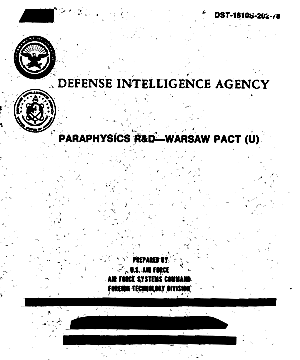
In 1978, a survey of 14 active psi research laboratories by Dr. Charles Tart revealed that five of those laboratories had been officially approached by officials or agents of the U.S. government who were gathering information on psi. The total known figure, at the time, for funding to mainstream psi researchers amounted to several hundred thousand dollars a year. Almost all the researchers surveyed maintained that using psi for espionage or military purposes was a very real possibility, and several were certain it was being done.
Probably more than in other areas of scientific investigation, it is information about who funds psi research research that is classified, not only what is being done. Former White House staffer, Barbara Honegger reported, for instance, that the very word "parapsychology" was classified at the CIA -- that is, a directive existed that it is not to be used in telephone conversations except over secure lines; and that any report with the word in it is automatically classified.
Of all the services, the Navy has historically been the most open-minded about taking psi research seriously and funding it. In 1975, the Navy reportedly funded SRI to see if psychics could detect sources of electromagntic radiation at a distance; and, in 1976, to see whether they could influence a magnetometer at Stanford University. The SRI scientists reported that they could. Critics of this set of results, however, argue that the project was guilty of "optional stopping" to achieve its results. The Navy was interested because magnetometers, which measure magnetic fields, are important in detecting submarines.
The Navy, according to knowledgeable sources, also tested self-professed psychics to see whether they could accurately describe maneuvers of a foreign Navy. A New York self-professed psychic, Shawn Robbins, has reported working with the intelligence community to track the movements of foreign nuclear submarines. Robbins was originally tested at the Maimonides Hospital Psychophysics Laboratory in Brooklyn, New York. (However, her psi abilities were not determined to be significant at that time.)
Columnist Jack Anderson claims the navy also funded the controversial research by polygraph expert, Cleve Backster, on the alleged ability of plants to detect and respond to unspoken thoughts and feelings of living organisms, ranging from humans to brine shrimp. However, according to other sources, it was the army that funded Backster’s research, in the hopes of "training" plants to cost-effectively detect intruders in dangerous, security-sensitive areas.
According to information revealed to Barbara Honegger, during the Reagan administration for the first time the CIA officer in charge of keeping abreast of psi research noted in his periodic report to the National Security Council that there is growing reason to take the field more seriously.
The fundamental reason for this increased interest is initial results coming out of laboratories in the United States and Canada that certain amplitude and frequency combinations of external electromagnetic radiation in the brainwave frequency range are capable of bypassing the external sensory mechanisms of organisms, including humans, and directly stimulating higher level neuronal structures in the brain.
This electronic stimulation is known to produce mental changes at a distance, including hallucinations in various sensory modalities, particularly auditory. The analogy of these results to some spontaneous case reports in the psychical research literature has not escaped notice by the CIA, which is following the research.
A development during the first months of the Reagan administration was the release by the House Science and Technology Subcommittee, chaired by Representative Donald Fuqua, containing a chapter and supporting appendix on the "Physics of Consciousness" (mispelled "conscience" in the table of contents). The report recommends that psi research deserves serious attention by Congress for potential future funding. It states that,
"general recognition of the degree of interconnectedness of minds could have far-reaching social and political implications for this nation and the world."
The primary sources cited in the report are the research studies of Harold Puthoff and Russell Targ at SRI International, and a report prepared by William Gough, Technical Director of the office of Program Assessment and Integration of the U.S. Department of Energy. Gough published the cited report under the auspices of the Foundation for Mind-Being Research.
A statement of U.S. government interest in psi-war scenarios appeared in the private publication, Military Review, by Lieutenant Colonel John B. Alexander. Alexander asserted that psychotronic weapons already exist and that their lethal capacity has been demonstrated.
He was referring here predominantly to the claims of Lt. Colonel Thomas E. Bearden that third-generation psychotronic weapons, including what he called a "photonic barrier modulator: which induces physiological changes at distances, near or far; the ’hyperspatial howitzer,'" which allegedly can transmit nuclear explosions to distant locations; and a radionics-type device which, Bearden contended, sank the U.S. nuclear submarine Thresher in 1963.
Alexander’s claims were unnecessarily alarmist in nature and a number of them are known to be either exaggerated or erroneous. He stated, for instance, that research in the Transcendental Meditation Sidhis Program has produced evidence that individuals are taught in the program to levitate. Investigations into this claim have found it unsupported by any valid observations or measurements.
In 1988, the U.S. Army commissioned a study on a variety of techniques purporting to enhance human performance.
Accident prevention
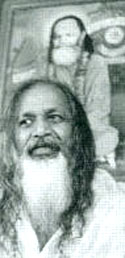
Maharishi Mahesh Yogi
The claim is made with the Transcendental Meditation (TM) program that the practice of TM by many individuals creates an unexplained effect on the "social field" which results in reduced accidents, foul weather, sickness and crime -- as measured by statistical social indicators. Although these claims are presented in a quasi-empirical fashion -- with statistics and control groups -- they have yet to be seriously presented or evaluated in the academic literature of either sociology or psi research.
The methodological problems inherent in any study conducted by an organization for the purpose of promoting training offered by that organization are sufficient to merit skepticism in the absence of independent replication.
Dowsing
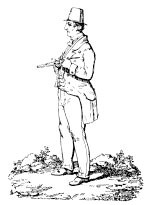
Dowsing, a poorly understood technique for finding underground water and minerals, seems to be gaining popularity as a result of increasing need for efficient development of resources. Some researchers maintain that dowsing involves an extraordinary sensitivity to anomalies in weak magnetic fields. This is probably true, but still does not represent the entire picture.
Henry Gross, perhaps America’s best known dowser, has in many instances been able to locate oil, water, minerals and even lost people by using only a map. Gross’s abilities were confirmed somewhat in tests conducted by J. B. Rhine and published in 1950 -- however these laboratory studies were admittedly not related to dowsing as practiced by Gross in his everyday life. Journalistic documentation of Gross’s actual work including the prevailing conditions, the people and areas involved have been published in a series of books by Kenneth Roberts.
In many instances Gross was apparently successful in pinpointing wells when conventional geological techniques had failed or had indicated there was no water. He dowsed water for many industrial concerns including RCA Victor and Bristol-Myers pharmaceutical company. He reportedly map-dowsed from Maine fresh water in Bermuda where none had been found in 300 years. In Kansas he dowsed thirty-six wildcat oil wells and of the seventeen that were drilled, it is claimed he was correct in fifteen instances. Seismic predictions were wrong in nine out of seventeen cases. Although a strong advocate of Gross’s abilities, Roberts also discusses a number of his failures.
Henry Gross’s talents were investigated by the New Jersey psychiatrist and psychical researcher, Dr. Berthold E. Schwarz. His investigations included psychiatric interviews, physiological studies and field trips. Schwarz found Gross -- a modest, friendly game warden -- to be a man of complete honesty.
The physiological data, as well as direct observation, indicated that Gross expended a great deal of energy in the dowsing process. In the field studies, Schwarz claims he observed Gross successfully dowse seven oil wells in an area where oil was not geologically expected. Gross also apparently ascertained depth, flow and other quantitative measures that were presumably beyond the ability of normal sense perception.
At the Laboratory of Physiological Cybernetics at the University of Leningrad under the directorship of Professor P. I. Gulyaev, research has been focused on the human ability to perceive faint electrostatic fields. This research has led to renewed Soviet interest in a phenomenon known in this country as dowsing, which the Soviets call the "bio-physical effect." Studies in this area were initiated by the Soviet geologist N. N. Sochevanov, who has reportedly documented several dozen cases in which dowsing has been successfully employed in mining and drilling projects. Dowsing is also currently taught to professional minerologists and geologists in the Soviet Union.
Dowsing has reportedly been successful in locating:
commercial grade gold ore near Krasnoyarsk
tin deposits in Kirghizia and Tadzhikstan
iron in the southern Urals
copper-nickel ores near Krasnoyarsk
lead and zinc ores in the Tadzhik SSR
gypsum in the Ukrainian SSR
Other reports describe finds in unspecified locations of molybdenum, bismuth, tungsten, bauxite and other economically and militarily valuable metals.
These findings may, if valid, be strategic importance, given that the future security of a nation depends on continued access to mineral resources. Because of this importance, it would be reckless to overvalue the anecdotal evidence suggestive of dowsing or other psionic claims. Section III summarizes a body of psychological research demonstrating many types of cognitive errors to which all humans -- skeptics and proponents alike -- are susceptible.
A clear perspective on dowsing (or any other folklore claims) can only be attained when skeptical arguments are carefully weighed against claims of proponents.
Treasure Hunting
One of the most dramatic uses of psychic talent to recover treasure reportedly occurred here in the United States. The National Inquirer commissioned the Chicago psychic Olaf Jonsson to assist treasure hunters in the search for the sunken ruins of Spanish galleons loaded with gold and silver bullion. Jonsson seemed to sense the spot as the search vessel approached it and he asked the crew members to form a circle and concentrate with him. Going into trance, he actually relived the sinking of the ships. Under his directions the divers reportedly recovered part of the fortune, valued at $300,000.
Some psychics have a difficult time, probably for psychological reasons, using their abilities for their own direct financial gain-although they perform satisfactorily when they charge others for "life readings," etc. Even Uri Geller fared very poorly in Las Vegas. (Although it would be interesting to test habitually successful gamblers for ESP.) The inabilities seem to be more a reflection of a person’s personality, rather than a limitation upon psi itself.
Accuracy of Information Transmission
A number of case histories also testify to this possibility. For example, Dr. Georgi Lozanov, director of the Institute of Suggestology and Parapsychology in Sophia, Bulgaria, is said to have demonstrated a very impressive communications technique using the majority-vote technique.
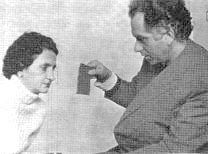
Dr. Georgi Lozanov with a subject (courtesy Milan Ryzl)
The telepathic receiver sits in front of two telegraph keys, one for each hand. Some distance away, the sender telepathically suggests that the receiver press either the right or left key, according to the beats of a metronome. Each telepathic suggestion is repeated ten times. The receiver must get six of these correct for the message to be considered received. Lozanov reported at the 1966 Parapsychology Conference in Moscow that phrases and entire sentences have been sent this way with about 70% accuracy. Thousands of such tests are said to have now been demonstrated before many scientists.
As the name of his institute implies, Lozanov is concerned with many of the psychological factors effecting ESP scores.
Using techniques derived from yoga, Lozanov combines suggestion and relaxation in a way that is different from hypnosis in that his subjects remain in the waking state. Used in education, these techniques show phenomenal promise to increase language learning, memory, artistic and musical ability. Lozanov also is applying his techniques towards the development of mental healing and dermal vision.
One of Lozanov’s many research activities involves the evaluation of the predictions made by the blind, peasant woman, Vanga Dimitrova, who may be the modern world’s first Government supported prophetess. (In fact, the Institute of Suggestology and Parapsychology, with over thirty staff members, is supported by the Bulgarian government.) Studies are reported to have shown that Dimitrova’s predictive abilities -- particularly strong in terms of finding lost relatives and friends--are about eighty percent accurate.56
In Prague, Czechoslovakia, things were somewhat different. Dr. Milan Ryzl, a biochemist at the Czech Institute of Biology, had spent years trying to interest the government in supporting psychic research -- all with very little success. Undaunted, Ryzl continued his own studies which involved hypnotic techniques for developing ESP subjects. After practicing on some 500 individuals, Ryzl claimed to have found fifty with very strong, testable psi abilities.
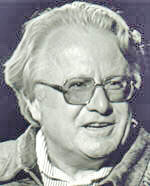
Milan Ryzl
Ryzl used his psychic subjects to predict the winning numbers in the Czech public lottery. He was successful for weeks in a row winning the equivalent of several thousand dollars. However, Ryzl’s psychical research successes also proved to be detrimental to his safety. The Czechoslovakian regime became very interested in his work. He found himself constantly followed by secret agents. His manuscripts were stolen. Eventually he was asked, in rather forceful terms, to spy on his scientific colleagues in other countries.
The authorities made it very clear they were interested in the development of psi techniques for espionage purposes. The government exercised such control over his life that Ryzl had no choice but to comply or defect. His escape from Czechoslovakia was a masterpiece in precise timing. He actually contrived to leave the country with his entire family in three automobiles and many valuable possessions including his prized library. Ironically, Ryzl recalls that the details of his defection had been predicted for him fifteen years earlier by a psychic who had been a friend of the family.
Researchers in socialist countries have continued the emphasis on the practical applications of ESP initiated by scientists such as Ryzl. Actually, since Ryzl’s defection, western psychical research has become somewhat more oriented toward practical uses.
Psychic Archeology
The use of psychics for archeological exploration has probably been the most extensively explored area of potential psi application. Its beginnings include the investigation of Glastonbury Abbey, perhaps England’s old Christian ruin, by Frederick Bligh Bond.
At the University of Toronto, Professor J. N. Emerson of the department of anthropology has reported on his use of psychic assistance in doing archeological field work. His friend, a psychic, George McMullen, has shown extraordinary ability to psychometrize artifacts and relate accurate details about the history and circumstances surrounding the object. George has also proven his usefulness in examining archeological sites before the digging begins.
Just by walking over a site, he has been able to describe its age, the people who lived there, their dress, dwellings, economy and general behavior. He has also provided specific excavation guidance. Emerson estimated that George’s clairvoyance is 80% accurate. Furthermore. Emerson has been able to achieve even greater degrees of accuracy by using teams of several psychics and evaluating their reports using a majority-vote technique.
In the Soviet Union, techniques of dowsing are applied to archeology. Chris Bird reports that the Russian anthropologist Pushnikov has successfully used psychic dowsers to probe the remains of the Borodino battlefield, seventy miles from Moscow, where the Russians battled Napoleon in 1812. Other Russian excavations utilized the talents of dowsers in probing the estate of the legendary Czar, Boris Gudenov.
The work of the Mobius Society is well known to the general public and the psychical research community. Stephan Schwartz began by looking at the role of psi in archeology. In his first book, The Secret Vaults of Time, he described a dozen cases in which archeologists have been successful in uncovering difficult to find locations and artifacts using psi methods. He then synthesized for himself a methodology, similar to the intuitive consensus method of Kautz, which relied on the overlapping judgments of a number of independent practitioners.
He has successfully used this method in a number of explorations. One of these, off the California coast on Santa Catalina Island, was broadcast on television. His explorations in Egypt have been the subject of several publications and scientific presentations.
Following guidance obtained from interviews with psychic respondents, researchers from the Mobius Group; in Los Angeles initiated an underwater archeological project in the Caribbean Sea. In September 1987, two respondents, Hella Hammid and Alan Vaughan were taken out in a small boat and within an hour had agreed on a site and dropped a buoy. The next morning divers noticed that a sequence of fire coral when viewed from one angle seemed unnaturally symmetrical. When one of the fire corals was chipped, it revealed what was later determined to be a bronze keel bolt.
The buoy dropped by Vaughan and Hammid was approximately 10 feet from the site. Four weeks of excavation revealed an unusually intact wreck buried 3 to 5 feet beneath the eel grass and sand. Nothing was visible except the fire coral covered keel bolts and some ballast mixed with natural rock. It required substantial excavation to uncover the remains of a collapsed American armed merchant brig that sank in the early decades of the nineteenth century.
What are the odds of finding the wreck described by luck? There is no completely satisfactory statistical answer to this question. The Mobius researchers justify their approach:
Unlike a laboratory experiment with a known baseline, no absolute probability can be given in an archeological experiment; fieldwork applications of psi are inherently different from in-lab experiments. However, vigorous concurrent utilization of non-psi electronic location technologies can serve as field controls in a double or triple blind setting, producing results as significant, in the author’s view, as low p values.
For example, 85,000 shipwrecks identical to the one reported here could be fitted into just the Northern Consensus Zone, and under optimal conditions, it could take several months of magnetometer survey work to locate one such wreck. This wreck was psychically located, and the location verified, in less than five hours.
Critics respond that the Mobius reports do not account for buoys dropped at other sites where shipwrecks were not located.
Psychic Police Work
The use of psychics by police for solving crimes goes back many decades. As early as 1914, the Frenchman W. de Kerler, calling himself a psycho-criminologist, demonstrated on many occasions, without any reward or publicity, his ability to solve crimes that baffled police. Some of his many alleged exploits have been recorded. In 1925, another case of clairvoyant detective work came to the attention of the German public. In this case, the psychic, August Drost, was on trial for fraud.
The case resulted from an incident in which he had attempted, with little success, to help officials solve a burglary. During the trial, which lasted for several weeks, much of the testimony pointed toward Drost’s successful ESP crime solving in other cases. He was acquitted and continued to practice his unorthodox detective work.
Another psychic detective, Janos Kele, worked for years in Hungary and Germany without ever accepting fees or rewards. His abilities were tested by Professor Hans Dreisch at Leipzig University who pronounced him a "classic clairvoyant." He was also successfully tested by Dr. Karlis Osis, then at Duke University. According to Dr. Stephen Szimon, a deputy police chief in Hungary, Kele averaged 80 per cent accuracy in the clues he provided for tracing missing persons.
Today in the United States, a number of police officials have publicly credited clairvoyants who have helped them with difficult investigations. One of the most prominent of these seers is Marinus B. Dykshorn, a Dutchman, whose autobiography is titled, My Passport Says Clairvoyant. Dykshorn’s career spans three decades and three continents. He currently resides in the U.S. For his psychic detective work he has twice been made an associate member of the Sheriffs Association of North Carolina.
In May, 1971, he received a commission from Louis B. Nunn, the governor of Kentucky as a Kentucky colonel, "in consideration of outstanding achievement." Dykshorn’s book contains ten notarized affidavits from individuals who have received benefit from his clairvoyant abilities. It is particularly interesting to note in his book the difficulties that he had getting researchers interested in testing his abilities, well after his practical successes had been acclaimed.
A psychic who has established lasting relationships with police authorities is Irene F. Hughes of Chicago.
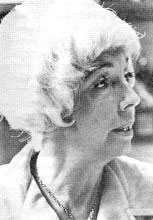
Irene Hughes
She is the head of an organization called the Golden Path where she has taught classes in psychic subjects and tests students interested in developing their own psychic abilities. On the wall of her office, a plaque signed by three Chicago policemen expresses appreciation for the leads she has given in solving a number of cases. In one particular homicide case, Mrs. Hughes was able to provide police with the name and address of the murderer -- adding that the case would take a long time to solve. It was, in fact, almost three years before the fugitive was found. According to crime reporter Paul Tabori, she is credited by police in Illinois with having helped to solve no less than fifteen murder cases.
Other tested psychics who are known to have worked with police officials include Olaf Jonsson and Alex Tanous. Undoubtedly there are more who prefer to work quietly and without publicity. Police departments receive a regular stream of tips that allegedly come from psychic insights. Most of them simply do not prove useful. Nevertheless, this area deserves further exploration.
Paul Tabori writes of the Viennese Criminological Association meeting he attended in the early 1930s devoted to the question of "so-called occult phenomena" in police procedure and judicial investigation. Many learned academics voiced the opinion that clairvoyance, telepathy, and even hypnosis were too unreliable to be used with any advantage in police and judicial work. Equally insistent however were lawyers and police themselves who stated practice had proved the value of psi in certain investigations and that it was foolish to reject it simply because of experimental and theoretical difficulties.
Great caution must be exercised in evaluating psi claims related to crime investigation. Skeptical Dutch researcher, Piet Hein Hoebens, for example was able to find major loopholes in claims regarding the Dutch clairvoyant Gerard Croiset -- "the Mozart of Psychic Sleuths." Newspapers throughout Europe acclaimed Croiset as a great psychic, at the time of his death in July 1980.
This is particularly disturbing, since Croiset’s abilities were attested to by W. H. C. Tenhaeff, a psi researcher at the University of Utrecht in the Netherlands, who had studied Croiset’s alleged abilities for several decades.
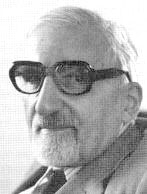
W. H. C. Tenhaeff
Hoebens investigation strongly suggests either incredibly shoddy research or fraud on the part of Tenhaeff.
With such a history, it is understandably risky for me to report psi crime investigations with which I am personally acquainted. Yet, for some years I have been monitoring Kathlyn Rhea, a psi practitioner now living in Novato, California.

Kathlyn Rhea
Author of Mind Sense and The Psychic is You, she is well-known for her work with police departments., She has been active on well over 100 cases.
One case in particular provides evidence that Kathlyn Rhea was directly instrumental in locating a missing body. I personally obtained complete corroboration from the law enforcement officials involved. The case occurred several years ago in Calavaras County, California, in the foothills of the Sierra Nevada gold country. An elderly man, Mr. Russ
Comments
Post a Comment